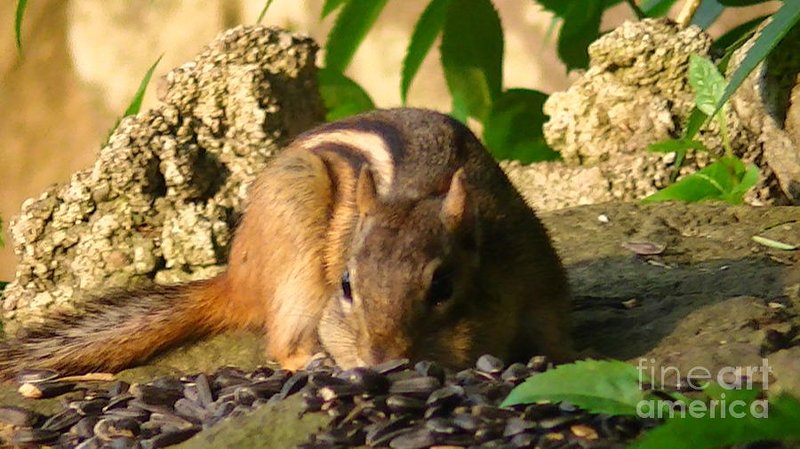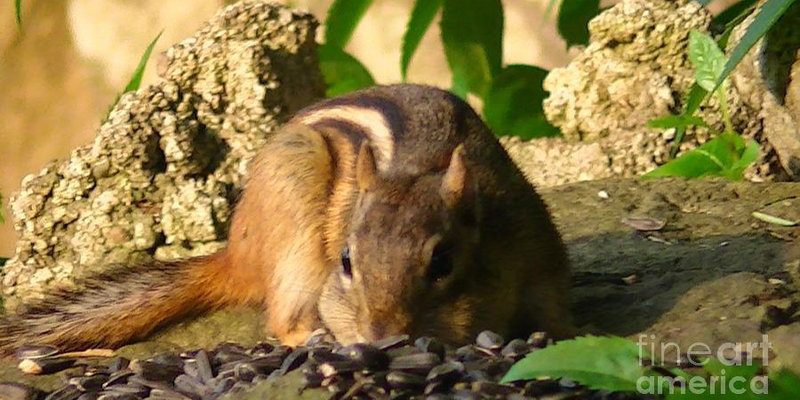
Imagine a small, adorable creature darting across the forest floor, its cheeks stuffed with acorns. That’s a chipmunk for you! These charming little rodents belong to the squirrel family and are known for their playful behavior and eye-catching stripes. Chipmunks are often spotted in backyards, parks, and woodlands across North America, where they thrive in a variety of habitats. With their small size and energetic nature, they capture the hearts of many nature lovers.
Chipmunks are primarily active during the day, which makes them a delightful sight for those who enjoy observing wildlife. They have a distinctive habit of gathering and hoarding food, which they stash away in their cheek pouches. This behavior not only helps them survive harsh winters but also showcases their resourcefulness. Their lively antics often remind us of childhood days spent playing outside, making them relatable and endearing.
In terms of physical appearance, chipmunks are small—typically around 5 to 6 inches long—and have striking fur patterns. Their fur is usually a mix of brown, black, and white stripes that run down their backs, giving them a unique look that makes them easy to identify. Not to forget their big, expressive eyes and twitching noses that add to their charm. Overall, chipmunks embody a delightful blend of cuteness and resilience!
Chipmunk Species
There are several species of chipmunks, but the most recognizable one is the eastern chipmunk (Tamias striatus). This chipmunk is found in the eastern United States and Canada. Other species, like the Siberian chipmunk (Tamias sibiricus), are found in parts of Asia and also share similar characteristics. Each species has adapted to its environment, but all chipmunks share the same playful spirit and foraging habits.
Chipmunks have developed specific adaptations that suit their habitats. For example, the Long-eared chipmunk has a longer tail than other species, which can help with balance as it moves among tree branches and shrubs. Meanwhile, the Western chipmunk tends to have slightly different coloration and patterns that allow it to blend into the western landscapes it calls home.
Understanding these differences can deepen your appreciation of chipmunks. Each species plays a crucial role in its ecosystem by dispersing seeds and providing food for predators. The variety among chipmunk species reflects the adaptability and resilience of these small creatures, showing how nature can evolve in fascinating ways.
Habitat and Distribution
Chipmunks typically make their homes in forests, gardens, and shrubby areas. They prefer habitats that offer plenty of cover, such as low shrubs and rocks, which provide not only shelter but also places to hide from predators. This cozy environment is essential for their survival, as it helps them stay safe while they forage for food.
In terms of distribution, chipmunks can be found across much of North America, primarily in the United States and Canada. They love areas with a mix of trees and open spaces, as this combination allows them to thrive. Interestingly, you might even spot chipmunks in urban parks or your backyard, where they make themselves right at home.
Given their adaptability, chipmunks can also thrive in varying altitudes—from low valleys to mountain regions. This versatility is vital as it allows chipmunks to occupy different ecosystems and maintain their populations. Learning about their habitat helps us better understand the delicate balance of nature and the importance of preserving these environments for future generations.
Diet and Foraging Behavior
Chipmunks are omnivores, which means they have a varied diet. They primarily feed on seeds, nuts, fruits, and insects. One of their favorite foods is acorns, which they gather in large quantities during the fall. This behavior is known as hoarding, and it’s critical for their survival during the winter months when food is scarce.
When foraging, chipmunks are quite clever. They often use their cheek pouches to store food temporarily, allowing them to carry more than they can hold in their small paws. Once they find a stash, they scamper back to their burrows, storing food deep underground. This not only keeps their snacks safe from other animals but also ensures they have enough supplies to get through the tougher seasons.
Their foraging behavior is fascinating to watch. You might notice a chipmunk pausing frequently, checking its surroundings for danger. This vigilance is key to their survival, helping them stay alert against predators like hawks, cats, and snakes. Understanding their diet and foraging tactics reveals not just their resourcefulness but also their place in the ecosystem as a forager and seed disperser.
Reproduction and Lifespan
Chipmunks have a relatively short lifespan in the wild, averaging around 2 to 3 years. However, with the right conditions, some can live up to 8 years. Their reproductive cycle is typically seasonal, with mating occurring in late winter or early spring. Females usually give birth to a litter of about 2 to 8 young after a gestation period of about 30 days.
The baby chipmunks are born blind and hairless, relying entirely on their mother for care. They start to venture out of their burrow after about 6 weeks, learning to forage and explore their surroundings. This early independence is essential, as it teaches them the skills they need to survive on their own.
While the short lifespan of chipmunks might seem sad, it’s important to remember that they play a vital role in their ecosystems. Their quick reproduction helps maintain population numbers, ensuring that these delightful creatures continue to thrive in natural habitats. Watching chipmunks grow from tiny babies to independent adults can be a heartwarming experience!
Chipmunk Behavior and Communication
Chipmunks are known for their lively and curious nature. They are social creatures and often communicate through a variety of sounds. These include chattering, squeaking, and even a high-pitched trill, which are all ways they express excitement or warn others of danger. Their vocalizations add to their charm and make them entertaining to watch.
When interacting with each other, chipmunks engage in playful behaviors, such as chasing and wrestling. This playfulness is essential for their development, helping young chipmunks learn social skills and establish boundaries. You might find them playfully sparring with each other as they build confidence and agility.
Additionally, chipmunks are highly territorial. They mark their territory by leaving scent markings, which helps communicate their presence to other chipmunks. This behavior ensures that they maintain their space and resources while avoiding unnecessary confrontations. Understanding their behavior and communication can enhance our appreciation for these small, delightful creatures.
Chipmunk Conservation Status
While chipmunks are generally abundant, some species face threats from habitat loss and climate change. Urban development often encroaches on their natural habitats, reducing the areas where they can thrive. As we continue to expand cities and modify landscapes, it’s crucial to be mindful of how this impacts local wildlife.
Conservation efforts are vital to help protect chipmunks and their habitats. Simple actions like preserving green spaces, planting native plants, and educating others about the importance of these creatures can make a significant difference. The more we learn about chipmunks, the better we can advocate for their wellbeing.
Furthermore, supporting wildlife organizations dedicated to protecting natural habitats can also help chipmunks and other wildlife thrive. Understanding the ecological importance of chipmunks and their role in the environment can inspire a sense of responsibility in us all as caretakers of nature.
Interesting Facts About Chipmunks
| Size: | About 5 to 6 inches long |
| Habitat: | Forests, gardens, and shrub areas |
| Diet: | Seeds, nuts, fruits, and insects |
| Speed: | Can run up to 21 miles per hour |
| Lifespan: | Average 2 to 3 years; up to 8 in captivity |
FAQ
What are the main threats to chipmunks?
Chipmunks face several threats, primarily from habitat loss due to urbanization and deforestation. As human development expands, chipmunks lose their natural homes, which can lead to population declines. Additionally, climate change poses risks by altering their habitats and food availability. Conservation efforts are crucial to mitigate these threats and protect these charming creatures.
Can chipmunks be kept as pets?
While chipmunks are adorable, they are wild animals and not typically suited for domestication. They thrive in their natural environment and have specific needs that are challenging to meet in captivity. Keeping a chipmunk as a pet can lead to stress for both the animal and the owner. If you’re interested in having a small pet, consider domestic rodents like hamsters or gerbils.
How many different species of chipmunks are there?
There are about 25 species of chipmunks, with the eastern chipmunk (Tamias striatus) being the most common. Each species has adapted uniquely to its environment, and while they share many similarities, they also exhibit distinct characteristics that reflect their habitats. Learning about these species can enhance your appreciation of chipmunks as a whole.
What do chipmunks do in the winter?
During winter, chipmunks enter a state known as “torpor,” which is similar to hibernation but not as deep. They do not hibernate continuously; instead, they wake periodically to eat food that they have stored in their burrows. This adaptation allows them to survive the cold months when food is scarce while minimizing energy expenditure.
Are chipmunks social animals?
While chipmunks can be seen interacting with each other, they are predominantly solitary creatures. They tend to establish territories and are quite protective of their food sources. However, during the breeding season, they may tolerate each other more as they search for mates. Their social interactions, though limited, can be quite playful and entertaining.
How can I attract chipmunks to my backyard?
To attract chipmunks, create a welcoming environment by planting native plants and providing food sources they love, such as seeds and nuts. You can also set out small feeders or scatter food on the ground. However, be mindful of attracting other wildlife, like squirrels or birds. Providing a cozy shelter, such as a rock pile or brush pile, can also entice them to visit your yard.
Do chipmunks have predators?
Yes, chipmunks have several natural predators, including hawks, owls, snakes, and domestic cats. Their small size makes them vulnerable, so they rely on their agility and quick reflexes to escape danger. Chipmunks are adept at hiding and using their surroundings to avoid being spotted, which is essential for their survival.
What sounds do chipmunks make?
Chipmunks are known for their vocal qualities, often making a range of sounds. They produce chattering and squeaking noises, which can signal excitement or act as warnings to others. Some might even hear a high-pitched trill, which is a unique component of their communication. Observing these sounds can provide insight into their behavior and interactions.
Do chipmunks hibernate?
Chipmunks do not hibernate in the traditional sense. Instead, they enter a state of torpor, where their metabolism slows down significantly, allowing them to conserve energy during cold months. They will wake from this state to eat from their stored food supplies, ensuring they have enough nourishment to survive until spring arrives.
Can chipmunks bite?
Yes, like any wild creature, chipmunks can bite if they feel threatened or cornered. However, they are generally not aggressive and prefer to flee from danger rather than confront it. If you encounter a chipmunk, it’s best to observe from a distance to avoid startling them. Remember, they are wild animals, and their natural instincts should be respected.

